Many of you know the game I’m going to write about today. Don McLean doesn’t play a concert without “American Pie.” And I’m not going to write a lifetime retrospective of my chess games without my game against David Pruess. It’s already been published in lots of places: Chess Life, Chess Informant, Jonathan Speelman’s Agony Column. It was even a Game of the Day at chessgames.com. Nevertheless, I’m sure that some of my readers have not seen it before. I’m happy to show it to you, and I’ll try to do it in a fresh way.
It was the sixth and final round of the 2006 Western States Open in Reno, and so far it had been a good tournament for me. I lost in round one against GM Enrico Sevillano, but that was no great surprise. In round two I won this amusing miniature against Drayton Harrison, a class-B player:
Dana Mackenzie — Drayton Harrison, 10/6/2006
1. e4 c5 2. f4 d5 3. Nf3 de 4. Ng5 Nf6 5. Bc4 Bg4?! 6. Qxg4! Nxg4 7. Bxf7+ Kd7 8. Be6+ Kc6 9. Bxg4 …
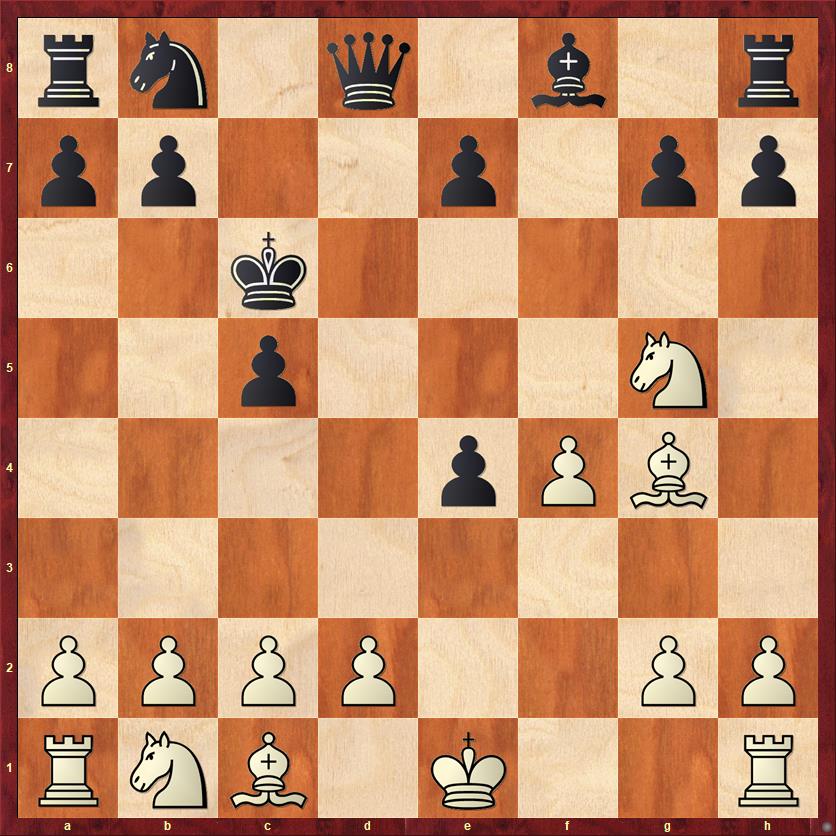
FEN: rn1q1b1r/pp2p1pp/2k5/2p3N1/4pPB1/8/PPPP2PP/RNB1K2R b KQ – 0 9
Remember this position! You’ll see it again.
My opponent played what seems to be the most logical response to White’s way-too-early queen sacrifice:
9. … e5
This move may even be best, provided that it is played as a line-opening pawn sacrifice. But that was not Harrison’s intention.
10. Nf7 Qh4+ 11. g3 __xg4
I have written the move in this peculiar way because of what actually happened. After I played 11. g3, my opponent immediately grabbed my bishop… and then he saw the trap: if he takes my bishop, I will fork his king and queen.
As you know, the touch-move rule says that if you touch your opponent’s piece and you can legally take it, you must take it. So Black has now committed himself to 11. … Qxg4. But he sat at the board for close to 10 minutes, still cradling that bishop in his hand. I don’t know what he was thinking about. Maybe waiting for me to leave the board so he could put the bishop back? Sorry, I wasn’t going to do that. One of my friends, who was playing in the tournament but also watching my game, loitered around in the area in case I needed an eyewitness to say that Black had touched the bishop.
But in the end, no eyewitness testimony was needed. After 10 minutes, my opponent finally completed his move:
11. … Qxg4?? 12. Nxe5+ Black resigns
This game was, to the best of my knowledge, the debut of the queen sacrifice 6. Qxg4! in over-the-board tournament chess. So it’s actually a historic game.
However, the queen sacrifice variation was known in postal play long before then. The pioneer was Arne Bryntse, a Swedish correspondence champion who used it in the 1960s and early 1970s. He usually got into it via Bird’s Opening, with 1. f4 d5 2. Nf3 c5 3. e4!? It has also been adopted successfully by Wladyslaw Krol, an International Master and Senior International Master of correspondence chess who is still active. It should in my opinion be known as the Bryntse Gambit, but on chessgames.com they call it the Batavo Gambit for some reason.
I was at first not aware of the games of either Bryntse or Krol. I started experimenting with 1. e4 c5 2. f4 d5 3. Nf3!? de back in 2001 or so, thinking of it as a reversed Budapest Gambit. White has the extra move f2-f4, but it is not clear whether this helps him or hurts him. At first I played 4. Ne5, motivated by the Fajarowicz Variation of the Budapest, and I actually had a couple of good games against masters with it, one win and one near-win. Intuitively it seems to me that 4. Ne5 is a more principled move than 4. Ng5, but unfortunately when I played it against the computer I always found myself fighting for a draw. That totally changed when I started playing 4. Ng5. I found that the computer enthusiastically went queen-hunting every time, playing 4. Ng5 Nf6 5. Bc4 Bg4?! I gradually worked out a system for playing against this line, first against Fritz 7 and then against Fritz 9. The system was not based so much on memorized moves but on general principles, which we could call the Five Commandments:
- Thou shalt not open files. Black has more straight-moving pieces (queens and rooks) than White. By keeping files closed, White limits their activity. On the other hand, White should be eager to seize any open diagonals.
- Thou shalt exchange one of thy knights for Black’s bishop. This will give White two unopposed bishops, which in many cases are as strong or stronger than Black’s two rooks.
- Thou shalt keep Black’s queen under lock and key. When things go wrong for White, it’s usually because the queen has been allowed to become too active.
- Thou shalt not covet thy opponent’s material. (Or, “Thou shalt not cash in too soon.”) You will likely get many opportunities to win an exchange. This typically leads to a R+B+P versus Q situation, with considerable easing of the pressure on Black’s position, and not as many winning chances for White. It’s better to wait and keep the pressure on.
- Thou shalt be patient, for time is on thy side. The goal is to overwhelm Black’s army of giants with your army of ants. This may seem counterintuitive. Normally, queen sacrifices are played with the intention of setting up a mating attack. But not this one! We’re not aiming for checkmate on move 20, we’re aiming to totally exhaust and demoralize Black by move 50. (You can actually see this better in my game against GM Sergei Kudrin, but it happens to some extent in the Pruess game, too.)
Of course, these commandments are not as absolute as some other commandments you might have heard of, but I do think they give you a terrific way of orienting yourself amidst the complexities of the Bryntse Gambit.
For the longest time, though, I didn’t have any opportunity to try them out against a human opponent. There are many ways that Black can avoid this queen sacrifice variation. First, he doesn’t have to play the sharp Tal Gambit with 2. … d5. He could play 2. … Nc6 or 2. … d6 or 2. … g6. The next major off-ramp is on move five, when Black has the option of playing more cautiously with 5. … e6, rather than chasing White’s queen with 5. … Bg4. Humans typically are more careful or less greedy than computers, so this happens often.
So even though I had been playing the queen sac against the computer since 2004 or even earlier, I didn’t get a chance to play it against a human until 2006. The game against Harrison was the first, but of course it was not a true test of the opening. The true test came two days later, in round six against International Master David Pruess.
At the time of this game, Pruess was very much an up-and-coming star. He had won the Samford Fellowship, had earned two grandmaster norms, and had a 2461 rating, which made him #64 in the country. According to the USCF web page he was the second-highest-rated player I’ve ever beaten. Two or three years after this game, having failed to get his third GM norm, he made a conscious decision to scale back his chess ambitions and devote more energy to getting chess.com up and running. This was a decision that many in the chess community can be grateful for. I also want to say that David is one of the finest gentlemen I have ever met over a chess board. When I call this a game for the ages, I do not ever mean any disrespect to him.
Dana Mackenzie — David Pruess, 10/8/2006
1. e4 c5 2. f4 d5 3. Nf3 de 4. Ng5 Nf6 5. Bc4 Bg4?!
“I was not going to be intimidated into playing a move that isn’t the best [5. … e6], just because it looks as if my opponent might get a few threats.” — IM David Pruess
“David’s need to refute anything that appears fishy to him overcame his common sense.” — GM Josh Friedel
6. Qxg4! …
“David Pruess is one of the most unflappable players I know. You can do anything to him and he won’t bat an eyelash. But when Mackenzie played that queen sacrifice, I saw a little tremor pass through him. That’s as big a reaction as you’ll ever get out of David Pruess.” — IM Emory Tate
6. … Nxg4 7. Bxf7+ Kd7 8. Be6+ Kc6
Black has two reasonable options. He could play 8. … Ke8, effectively inviting a draw by repetition. White then has to decide whether to take a draw or play 9. Bxg4, with play similar to the game but with Black’s king less exposed. This possibility of an early draw makes the Bryntse Gambit a better weapon to use against higher-rated players than against lower-rated players. Because Pruess was nearly 350 points above me, and because he had a chess philosophy summed up in the above two quotes, there was no chance in hell that he was going to play 8. … Ke8.
The other option is 8. … Kc7. I’ve never faced a human opponent who played this move, because there is an obvious problem: after 9. Bxg4, Black has to waste another move to defend against the threat of 10. Ne6+.
9. Bxg4 …
Arriving at the position in the first diagram. Black has so many options that it will make your head swim. That’s the beauty of the Bryntse Gambit: it’s essentially impossible to analyze it exhaustively. Here’s a quick look at the possibilities:
(a) 9. … e5. If Black can play like a computer, this may be the best move. But if Black is a human, I’ll take my chances with 10. Nf7 Qe8 11. Nxe5+ Kc7 12. Nc3 Bd6 13. O-O! If Black takes on e5 it plays right into my hands, giving me the unopposed bishops.
(b) 9. … Qd6. The computer seems inordinately fond of queen moves here, but I think they are ill-advised for humans because Black is playing with his “pretty piece” and neglecting everyone else. 10. O-O seems okay, and 10. d3! might be better than okay. I spoke above about being patient and not opening lines, but if Black continues to ignore opening principles, then White can reasonably sac material for more rapid development.
(c) 9. … Qd4. Ditto comments above. I typically play 10. Ne6 Qf6 11. O-O, but more adventurous players might want to try 10. d3. I don’t like 10. Nf7 (in this line or line b) because by chasing the exchange I would be violating the
Fourth Commandment.
(d) 9. … h5. More computer moves! But there’s an insidious trap: after 10. Bh3? e5! 11. Nf7 Qh4+ 12. g3? Qxh3 is no good any more for White. Instead White should play 10. Bf5, with the immediate threat of Bxe4+.
(e) 9. … g6. Now we’re getting into more human moves. I again like 10. Ne6, playing for restraint, rather than 10. Nf7, playing for material. After 10. Ne6 Qa5 the game can take a really startling turn with 11. b4!? But White may need to settle for a draw after 11. … Qxb4 12. Nd8+ Kc7 13. Ne6+. This is the second “quick draw” variation (the first one being 8. … Ke8 9. Bf7+).
(f) 9. … Nd7. Another developing move that for some reason I have not looked at carefully (maybe because the computer has never played it against me). As usual I am skeptical of 10. Nf7. This may be a case where White should blockade with the bishop rather than the knight: 10. Be6, when 11. Nf7 is now a more serious threat.
And finally there is
9. … e6,
the move that Pruess actually played. He was a little bit unlucky that he played the same variation that Fritz played most often against me. It’s a good try, which prepares to develop the bishop and avoids the blockade on e6 that happens in some of the above lines. Unfortunately for him, I was very well prepared for it.
10. Nc3 Na6
Played after a very long think (26 minutes). After 10 moves of a 40 moves in 2 hours time control, I have used 2 minutes and Pruess has used 1 hour and 3 minutes. Again, Pruess is unlucky that once again he chose the move that Fritz usually played, and I was ready for it. My game against Kudrin (2014) diverged here with 10. … Nd7.
11. a3! …
“This move should get two exclamation points. It’s unbelievable that White, after sacrificing a queen, can play such a quiet move.” — GM Jesse Kraai
I knew from bitter experience against Fritz that I cannot allow the knight to come to b4. But 11. a3 is not purely defensive; later on, it helps White hammer at the Black king’s protection with b2-b4.
11. … Bd6 12. O-O …
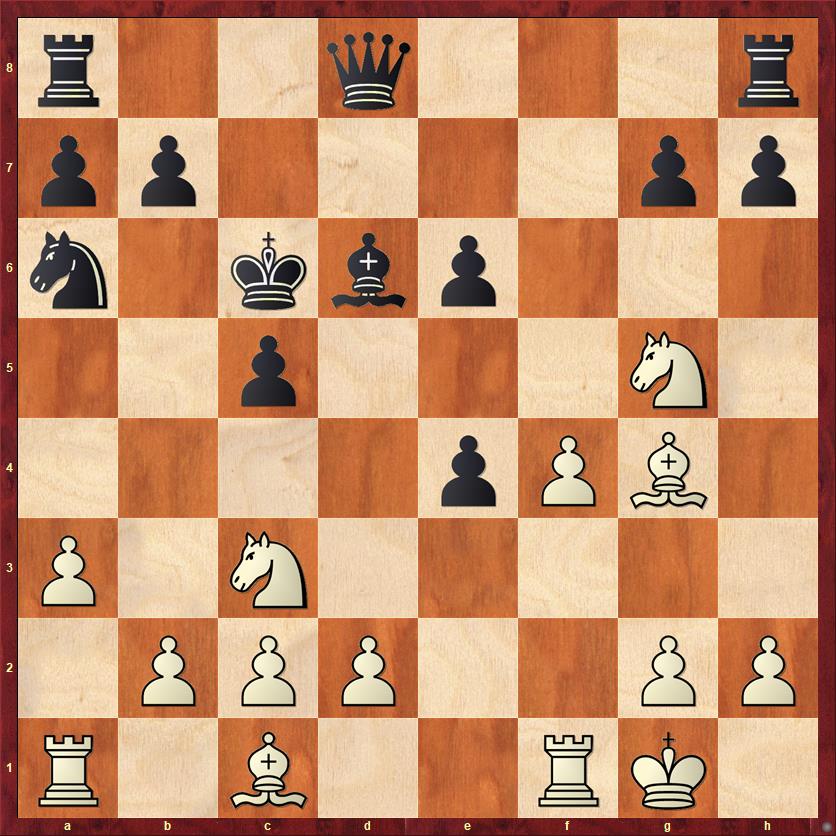
FEN: r2q3r/pp4pp/n1kbp3/2p3N1/4pPB1/P1N5/1PPP2PP/R1B2RK1 b – – 0 12
Although I’ve said that tactics aren’t the main focus in the Bryntse Variation, this is one moment when I had to be tactically alert. I was worried that Black could make trouble with the counter-sacrifice 12. …. Bxf4 13. Nxe6 Bxh2+ 14. Kxh2 Qh4+ 15. Bh3. In particular I was worried about 15. … g5, after which it looks as if Black might win my pinned bishop. However, the activity of White’s pieces is such that this can never happen. After 16. g3, 16. … Qh5 would be met by 17. Rf6! with a nasty discovered check threat, and 16. … Qh6 would be met by 17. d4!, pinning the g-pawn.
12. … Nc7 13. Ncxe4 Qe7 14. Nxd6 Qxd6
In accordance with the Second Commandment, I trade off a knight for Black’s remaining bishop. At this point, for the first time, Fritz 17 evaluates the position as equal. Pruess has not made any move that looks even slightly like a mistake; on the contrary, he has played very logical developing moves. This is why I consider the Bryntse Gambit completely sound for human play. There are a million variations, and the same thing seems to happen in all of them. Black’s “advantage” (as measured by chess engines) tends to melt away.
15. d3 Raf8 16. Bf3+ …
During the post-mortem there was a great deal of discussion about 16. Be3. But this is another case where principles win out over calculation. I would never have played 16. Be3 because after 16. … Nd5 17. Rae1 Nxe3 18. Rxe3 Qd4 White has violated two of the five commandments. I have given away one of my bishops, and I have allowed Black’s queen to start running rampage (which will happen after … Qxb2).
16. … Kd7 17. c3!? …
“Why not 17. Bxb7?” — GM Victor Michalevski
“Because it would be cashing in too soon. This opening is not about winning pawns — it is about active piece play.” — NM Dana Mackenzie
“Oho! The master has spoken! Let the master speak!” — GM Jesse Kraai, loving the fact that I was talking back to the Israeli grandmaster.
In fact, Fritz 17 agrees with Michalevski that 17. Bxb7 is best. What can I say? It just violates the spirit in which I play this opening. Perhaps they are right, though, because 17. Bxb7 does fracture Black’s pawn formation and strip away some protection from Black’s king.
17. … Nd5 18. g3 …
Again, White is in no hurry (Fifth Commandment). In accordance with the First Commandment, I am trying to keep the files closed.
18. … h6 19. Ne4 Qc7
The alternative 19. … Qb6 would run into 20. c4 followed by 21. Be3.
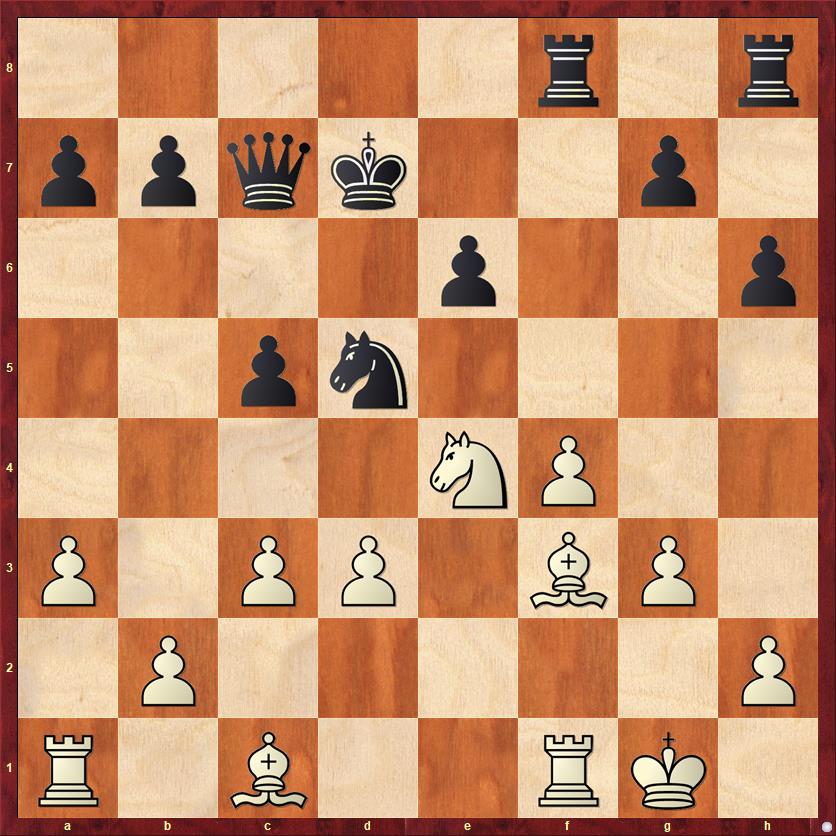
FEN: 5r1r/ppqk2p1/4p2p/2pn4/4NP2/P1PP1BP1/1P5P/R1B2RK1 w – – 0 20
20. b4! …
“You keep saying go slow, go slow, go slow. So why is it that on the one move where you had to go fast, you went fast?” — IM David Pruess
Because the way White wins is with his army of ants. And here comes the first ant.
Now we come to a turning point in the game. Until now Pruess has not played any moves you can reasonably criticize. But now he makes his first slight mistake.
20. … cb?!
This turns out to give White’s pieces too many open lines. Black should batten down the hatches and defend with 20. … b6.
21. ab b6
Black can’t take the c-pawn with 21. … Nxc3, because after 22. Nc5+, everything is suddenly under attack at once: a7, b7, and e6.
22. Bd2 …
The ants move forward. One step at a time. Believe me, I’ve done this before.
22. … Rf7
When I ran this game through Stockfish, it flagged this move (not the 20th move) as Black’s first mistake. But really, what is Black supposed to do here? His rooks have no open lines. His queen is under lock and key. The knight, his only somewhat well-placed piece, is about to be chased away.
23. c4 Nf6 24. Bc3 Ke7?
Black’s position is getting worse and worse. Probably he should have played 24. … Nxe4, just to reduce the army of attacking ants. Even so, the board would be completely dominated by my two bishops — it’s a very unpleasant position for Black.
25. Be5 Qd7 26. Nd6 Rd8
Black might have been tempted to return the queen for two pieces with 26. … Qxd6 27. Bxd6+ Kxd6. However, the torture is not yet over! In my notes after the game I wrote, “White wins a second pawn with 28. Ra6 followed by R1a1 and c5+.” But even stronger is 28. c5+! bc 29. Ra6+! Ke7 30. Rxa7+ Nd7 31. bc and White is cruising.
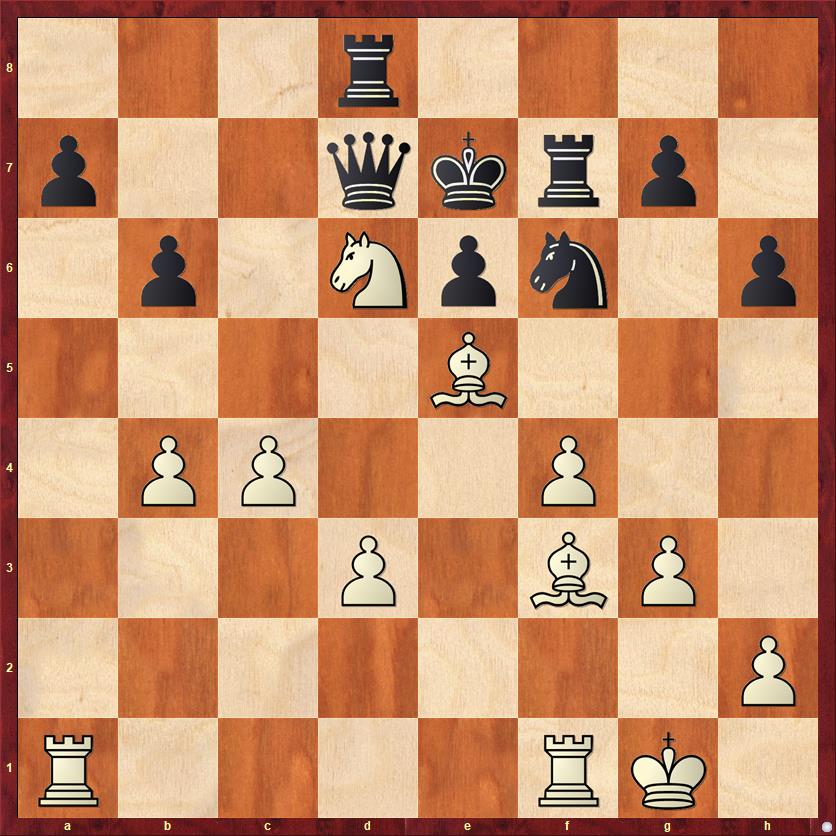
FEN: 3r4/p2qkrp1/1p1Npn1p/4B3/1PP2P2/3P1BP1/7P/R4RK1 w – – 0 27
Now I made my first mistake of the game. I violated the Fourth Commandment: “Thou shalt not cash in too soon.” White would have an overwhelming advantage after 27. c5, threatening c6, when Black’s queen has nowhere to go. The army of ants has arrived!
Instead I decided to “win” a rook for a knight. But in reality, I was “winning” a piece that is doing absolutely nothing, and giving away a piece that had a stranglehold on Black’s position. As a result the game continued for quite a few more moves than it needed to.
27. Nxf7? Kxf7 28. d4 Kg6?!
“Ever since move 24 I thought my game was lost, and so I played this move simply to confuse you.” — IM David Pruess
If so, this may be a case of the demoralization I mentioned earlier. Black has better moves than 28. … Kg6, which unnecessarily puts the king in a more vulnerable position. Fritz and Stockfish both like 28. … Rc8, which Pruess played on his next move. If Black can provoke c4-c5, then he starts getting some decent squares for his pieces — the knight can go to d5, the queen to b5. Still, of course, White stands better.
29. g4 Rc8 30. c5 Qb5
Black can’t play 30. … Nd5 because 31. Be4+ Kf7 32. f5 would be a catastrophe. (This points out why 28. … Kg6 was not such a great move.) Instead Pruess seizes the opportunity to activate his queen, even at the cost of a pawn. This is not a bad idea. Remember, as I said before, that when this opening goes wrong for White it’s usually because Black’s queen has gotten too active.
31. Rxa7 Qd3
Not 31. … Qxb4?? 32. Be4+ with mate next move! Again this shows the pickle that Black got himself into by playing 28. … Kg6. Still, 31. … Qd3 is a good, principled move, and the battle is not over yet.
32. h4 h5 33. g5 …
Perhaps the last critical moment of the game.
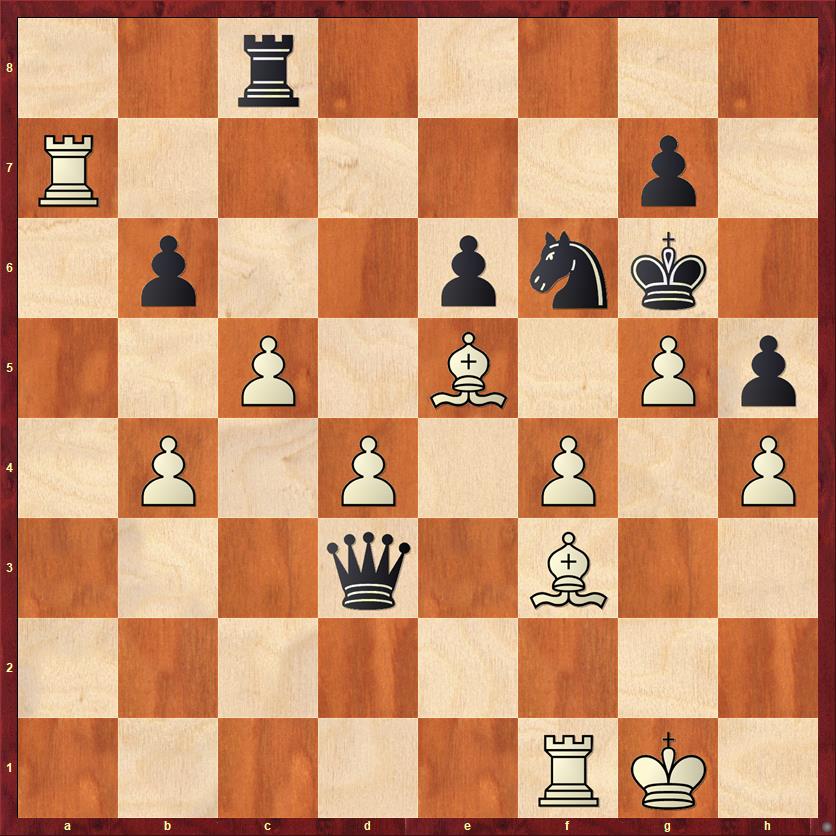
FEN: 2r5/R5p1/1p2pnk1/2P1B1Pp/1P1P1P1P/3q1B2/8/5RK1 b – – 0 33
“You know, I could have still drawn here with 33. … Ng4.” — IM David Pruess
During the game I was indeed worried about 33. … Ng4 and was surprised that Pruess didn’t play it. For example, if 33. … Ng4 34. Bxg4 Qg3+ is drawn according to the computer, or if 33. … Ng4 34. Rxg7+ Kf5 35. Bxg4 Kxg4! is also a draw. Black’s king turns into a fighting piece! Maybe this is what Pruess had in mind with his 28th move, in which case it was brilliant.
However, White has a lovely winning shot after 33. … Ng4, which I did not see at the board. GM Victor Michalevski found it in about two seconds. Can you find it?
The answer is 33. … Ng4 34. f5+!! A true grandmaster move, and one of the most unusual sweeper-sealers I’ve ever seen. The first point is that if Black captures on f5 with his queen or pawn, he seals off the king’s flight square and 35. Rxg7 is checkmate. Of course if Black captures on f5 with his king, he will lose his queen to a deadly discovered check, because the pawn move “swept” open the f-file. And finally, if 34. … Kh7 35. Rxg8+ Kh8 36. Bxg4 we see the third point of White’s sweeper-sealer: White has also “swept” open the diagonal for his bishop on e5 to go backward and defend g3! So Black has no hope of a draw by repetition, and he will lose more material thanks to White’s threat of discovered check against the king on h8.
A lovely, lovely discovery by GM Michalevski, and to me it is really the cherry on top of the sundae for this game. I will never know if I would have actually found 34. f5 at the board, but I hope I would have.
For whatever reason, Pruess decided that he could not afford to leave g7 unguarded, so he played a defensive move instead.
33. … Ne8 34. Kg2 …
Me, too. Defending g3 and f3, and freeing my rook for more active duty.
34. … b5
Black is basically saying, “I pass.” He can’t find any way to improve his position.
35. Re1 …
And now there is no stopping Be4+.
35. … Kf5 36. Be4+ …
Here the computer likes 36. Bxh5!, which threatens Rf7 mate. Black’s only way to stop it is to throw away a piece with 36. … Nc7 or 36. … Nf6. However, I can’t consider 36. Be4+ a mistake. It trades into a completely won endgame, doesn’t require any calculation and therefore also doesn’t entail any risk of miscalculation. That’s important because time is starting to become a factor. Long gone are the days when I was ahead of Pruess on the clock by an hour. Now he is ahead of me. I don’t know exactly how much time I had left at this point, but I think it was probably in the vicinity of five minutes for five moves. So simplicity was important.
I also liked the fact that 30 moves after my queen sac, I’m finally winning back the material with interest. This is one reason it’s hard for me to fully trust any computer evaluations of the Bryntse Gambit. If White’s threats are 30 moves deep, no computer will ever be able to get to the bottom of them.
36. … Qxe4 37. Rxe4 Kxe4 38. Ra5 …
A bit of a time-pressure move. It lets Black’s knight out of captivity, but Black does have to pay a price for its freedom.
38. … Nc7 39. Bxg7 Kxf4 40. Be5+ Kg4
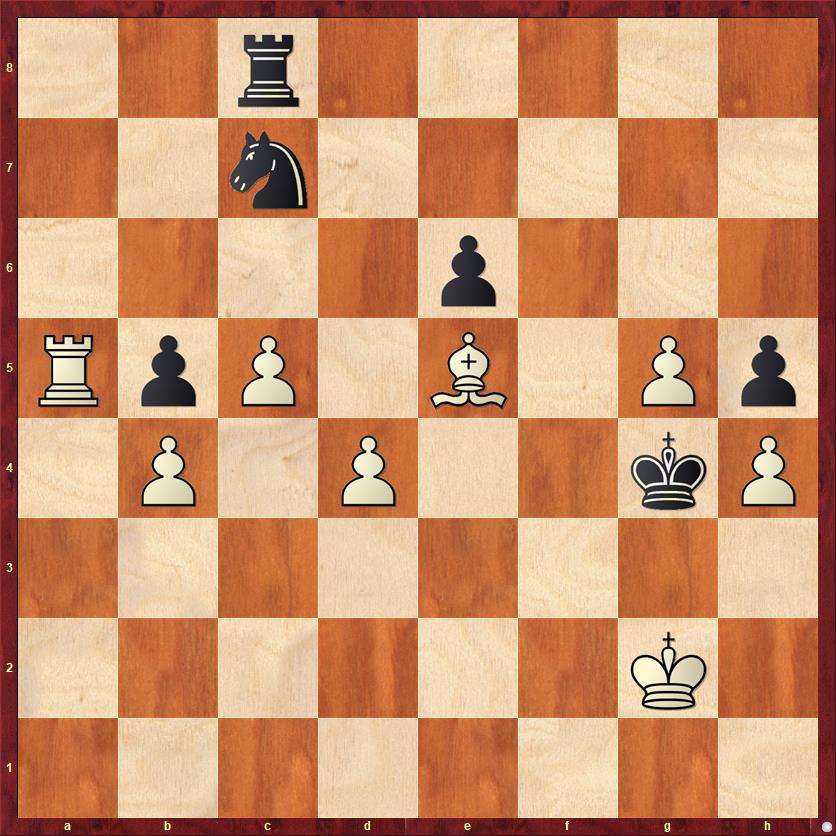
FEN: 2r5/2n5/4p3/RpP1B1Pp/1P1P2kP/8/6K1/8 w – – 0 41
Time control reached. White is completely winning. All I have to do is push pawns and watch out for tricks. And I have to give Pruess credit: he tried every trick he could find.
41. g6 Kxh4 42. g7 Rg8
Trick number one: If 43. Bxc7? Rxg7+ forks my king and bishop.
43. Ra7 Nd5 44. Rf7 Ne3+ 45. Kf3 Ng4
Trick number two: If 46. Rf8?? Nxe5+ 47. de Rxg7 would give Black some chances to hold.
46. c6! Black resigns
Next comes c7, and one pawn or the other is going to queen.
“This is the greatest game ever!!” — GM Jesse Kraai
“I lost my game because I was so distracted by all the c*** happening on Mackenzie’s board!” — IM Emory Tate, who was playing on the board next to us.
If any single chess game can be a life-changing experience, this one was. To start at the most basic and crass level, it was a six thousand dollar game. That breaks down into $560 that I won for the under-2300 prize; something like $600 that I earned for the Chess Life article that I wrote about the game; and finally, coolest of all, a recurring gig for ChessLecture.com. Jesse Kraai was so excited by this game that he invited me to lecture about it for that then-fledgling website. One lecture eventually grew into more than one hundred lectures, and over the next eight years I made somewhere around $4500 to $5000 total for them. It wasn’t much compared to my “real” work as a writer, but it’s the only time in my life that chess has ever given me any kind of recurring income. More importantly, I had a great time doing them, too, and there’s no way it ever would have happened without the Pruess game.
If you ask me what was my favorite thing about this game, though, it wouldn’t be the prize money or even the excitement of sacrificing my queen on move six. My favorite thing was the analysis session afterwards, when a dozen or more people, including strong masters and grandmasters like Kraai, Friedel, Tate, Michalevski, and of course Pruess were gathered around a big table arguing about my game.
As I wrote later for a semi-defunct web publication called Story Collider:
My greatest hope is that the debate will go on forever. The circle of players in the skittles room will argue late into the night, and then they will come back the next day and argue some more. The computers will continue to think they are winning, and yet will continue to lose. The departed queen will still weave her web of fascination and mystery, and hold her secrets close.



{ 11 comments… read them below or add one }
To be honest, I think 4. … e5 and 4. … Nh6 look very very good
Yes, I should have mentioned those “off-ramps” too. On 4. … Nh6 I probably just take on e4, either before or after playing Nc3. I think 4. … e5 is more interesting and I have not formed a clear opinion on what White should do.
In these side lines, I make no claim that White has a great advantage, just an okay game. So to some extent as White, you’re relying on Black to throw caution to the winds and play 4. … Nf6 and 5. … Bg4. The Bryntse Gambit is very effective against computers, which stubbornly stick to their belief that winning the queen for two pieces must be a Good Thing. The argument for playing it against humans is weaker. But if you know your opponent is an impulsive player, or he outrates you by 350 points (as in this game) then it’s definitely worth a try. At worst, you get an even game. At best, you get to play this wonderful queen sacrifice that is like chess on steroids.
These off ramps are the Budapest Gambit off-ramps. That would also include 4. … Bf5 although 5. g4 h6 looks completely crazy.
The 4. Nh3 against Budapest has been very poisonous, the knight is perfectly located on f4.
The 4. e4 line (popularized by Spassky AFAIR) is good enough by itself, but I think Black here gets some extra chances vs the exposed f-pawn.
Your best game/post ever
Wladyslaw Krol from Poland was playing the Fishing Pole 25 years ago in postal, 5 years before fellow Life Master and Brian Wall roommate survivor Jack Young and I started messing with it.
Wow! I thought you were the god of unconventional openings, but he came up with both of these variations before we did.
Did you have a better move than 43. Ra7?
I was looking at 43. Kf3 threatening to take the knight.
43… Nd5 44. Ra1 threatening to mate with Rh1
44. … Kh4 45. Rg1 with zugzwang.
Yes, I think that 43. Kf3 is more efficient, but I think you’ve got the Black king on the wrong square. It’s already on h4, not on h3, so 44. Ra1 doesn’t threaten mate and 44. … Kh4 is illegal because the king is already there! But anyway, there’s no question that 43. Kf3 Nd5 44. Rxb5 is totally crushing. It makes my move 38. Ra5 look like a smart move rather than a wasted move.
I guess the story behind 43. Ra7 is that I saw the plan Ra7-f7-f8 and thought it was a piece of cake. Then after Pruess played 45. … Ng4 I realized I had to be a little bit more careful, but fortunately plan B with 46. c6 was not hard to find.
You’re right. I thought the black king was on h3.
Can I suggest 43 Ra3 instead of 43. Kf3. The threat is 44 . Rh3+ 45. Rg3+ 46.Bc7.
If 43 … Nd5 or 43 … Ne8 44. Rg3 is a similar zugzwang.
The position at move 27, with White to play, is very rich with attacking ideas. If I was playing the Black pieces, and it was my move, I would play 27… Ne8 to evict the knight.
One move I was looking at for White, instead of 27. c6, which I agree is very strong, is 27. Ra3 threatening Rfa1, and also guarding d3 so the d6 knight is free to retreat without allowing Qxd3.
if 27… Ne8 29. Nb5 a6 30. Nd4 Rc8 31. Ra6 with too many threats.
if. 27… Rff8 28. Rfa1 Ra8 29. Ba8 Ra8 30. Ra7 Ra7 31. Ra7 Qa7 32. Nc8+
This has been the best post of this series so far. Thoroughly enjoyable. Standing ovation!
When we are too tired or overheated to study seriously (it was 108 degrees in Seattle yesterday) my study partner and I just look at games. I proposed this game and gave what I remembered of your Bryntse Gambit roadmap. Some moves after the Q sack his jaw dropped, and he said “You said patient but this guy is SO patient…it’s unreal….” Definitely a hit. We were far too warm to analyze but it was super entertaining just to watch! Thank you.